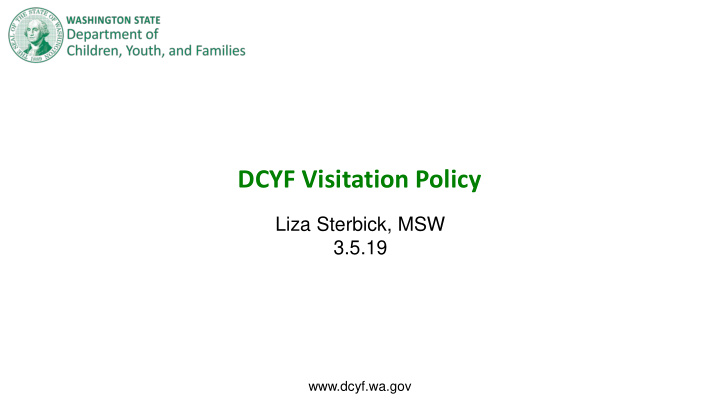



DCYF Visitation Policy Liza Sterbick, MSW 3.5.19 www.dcyf.wa.gov
DCYF Visitation Policy Key Elements • First visit occurs within 72 hours but no later than 5 days • Visits must be face to face unless extenuating circumstances exist Threats to child safety Inclement weather affecting safe travel, illness and distance. • Other forms of approved contact include: Telephone contact Electronic contact through video chat, Skype, Facetime or email Location: least restrictive setting • In the child’s community Age appropriate At DCYF office only if safety or other support required • Visits presumed unsupervised Unless threats/danger to child require constant presence of adult to ensure child safety • All cases require a written visit plan provided to parent and court www.dcyf.wa.gov
Visit Plan Development Initial plan developed at first FTDM when placement is being considered or child is in a • court-ordered placement Review initial plan at shared planning meeting after shelter care and no later than 30 days • prior to scheduled fact finding hearing Plan developed in consultation with parent, youth (age 14 and older), out-of-home • caregiver, CASA/GAL, child’s attorney, Tribal worker or designee, and other supports identified by the parent If plan calls for supervised or monitored visits, clearly state reason for the level of • supervision necessary to keep the child safe Visit plans reviewed at all shared planning meetings and monthly supervisory case reviews • Caseworkers must observe a visit every quarter • www.dcyf.wa.gov
Level of Supervision Decision The level of supervision is based on: • Risk Factors • Present Danger • Safety Threats • Protective factors demonstrated by the parent www.dcyf.wa.gov
Levels of Supervision Unsupervised • Parent is primary caregiver • Parent demonstrates willingness and ability to safely care for child for duration of visit • Parent protects the child from safety threats Monitored • Parent is primary caregiver • Approved adult is on site throughout the visit and conducts periodic checks in which they can observe/intervene Supervised • Approved adult to maintain line of sight and sound supervision www.dcyf.wa.gov
Natural Supports Utilize parent’s natural supports to act as monitors or supervisors Approved background and FamLink checks per the background check policy. Valid driver’s license if transporting. The transportation vehicle must be registered, insured, and equipped with approved child restraints, e.g., car seat, lap, and shoulder belts. Able to prioritize the safety and well-being of the child. Willing and able to intervene to keep the child safe & enforce visit rules, court orders, limitations, and activities. www.dcyf.wa.gov
Alternative Contact Preserving the parent-child relationship Concerted efforts made to promote, support and maintain a positive relationship between the parent and child in care through activities other than visitation. Medical/Dental appointments School activities Therapies
Parent-Child Visits-Key Elements Visit plans should be reviewed at all shared planning meetings and monthly supervisory case reviews Review includes: • Why visits cannot be unsupervised • If using a paid provider, why can’t visits be supervised or monitored by a non-contracted provider • Any continued risk factors or safety threats to the child www.dcyf.wa.gov
Questions? www.dcyf.wa.gov
Recommend
More recommend